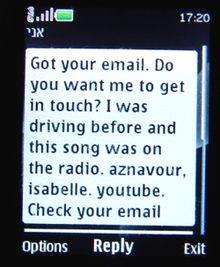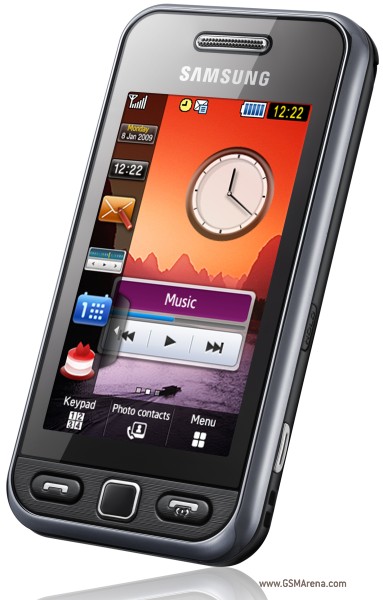Get used to new-fangled touch screen phones popping up like chic geeks at an LG Prada giveaway, thanks to the iPhone. HTC entered the game officially on June 5, 2007 with their showing of the HTC Touch. This is a Windows Mobile Professional (aka WM6 Pocket PC Phone) with a screen that's not only stylus-friendly like all PPCs, but finger sensitive. The screen requires a firmer touch than prior Windows Mobile devices, so if you get one, don't be shy-- press firmly for best results. The Touch uses a difference kind of touch screen to achieve finger-friendliness, especially gesture-awareness. It's not a multi-touch display like the upcoming iPhone and you can use a stylus, again unlike the iPhone which needs a human touch to work correctly. 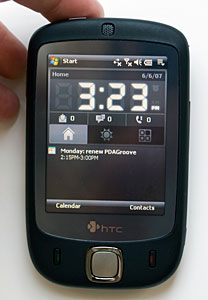 In conjunction with the finger-friendly screen hardware, HTC has created software that's easy to operate by finger, using tap and gestures. HTC has created a special home screen and an application that provide large, touchable targets; and in fact HTC has written their own touch screen driver. Here's the challenge, HTC can't re-write the entire Windows Mobile operating system to make it finger-friendly and gesture-aware. We'd have to leave that up to the folks in Redmond who author the OS. So you won't see a major transformation of the Windows Mobile 6 we've come to know and (err, love?). The Programs and Settings groups look and work the same. So do IE, email, contacts, calendar and solitaire. You'll face the same stylus-sized scroll bars and tiny 'x" close box up top. The HTC Touch Today Screen, which reminds us of Spb Mobile Shell. So what is different? There's the Today theme with quick access to an application launcher, the weather and a listing of calendar events. More interesting is the swipe action: swipe your finger from the bottom of the display to the top to bring up a spinning 3-sided cube (OK, not really a cube since there are only 3 sides, but you get the idea). Swipe from right to left (or left to right) to move through these faces. One has a palette of user-assignable images for your contacts. Put your favorite folks' photos in their, then tap on the picture to bring up their contact info in the address book. No, it doesn't dial them, you have to then hit the call button at the bottom of the screen. Flip your finger left or right to move to the next face of the "non-cube" which is an application launcher. The third face is for multimedia: HTC's music player (which unfortunately doesn't support as many file formats as Media Player Mobile), Photos (this launches MS' Picture and Videos app) and Videos (this also launches MS' Picture and Videos app). Swipe from the top of the screen to the bottom to hide the HTC UI. You can swipe up to bring up the HTC UI from anywhere, even inside an application. Swipe down to hide it again. Cool. The application launcher. |
|
The multimedia launcher face of the "cube".
| 
Speed dial. |
It's all very clever and pretty, though I'm not feeling it improves ease of use all that much since the special user interface doesn't extend beyond the Today Screen and the cube-launcher application. The on-screen keyboard is still the tiny Windows Mobile variety rather than a specially created one (or licensed 3rd party full screen keyboard) with larger keys that would make SMS possible via finger. So be prepared to whip out the stylus for text entry. And again, HTC isn't the author or owner of the OS, so there's only so much they can do. Phones like the Prada and iPhone have an easier time since their OS and UI were written together, allowing the touch metaphor to be pervasive. The HTC goodies work well and are easy to get the hang of-- good going there. And you can use the finger swipe to bring up the HTC cube when in any application. But HTC, why don't they work in landscape mode? That's right, there's no gesture support in landscape mode, so you can't bring up the cube-launcher and its finger-lovin' goodness. The touch screen has more glare than a standard PDA screen, so we had to tilt it for best viewing under sunlight.
Features at a Glance
Now that we've covered the touch screen and UI, let's get down to the basics. The HTC Touch runs Windows Mobile 6 Professional on a 201MHz processor with the standard 64 megs of RAM and 128 megs of flash ROM. It's an unlocked triband GSM phone with EDGE for data. The first version released will be triband 900/1800/1900MHz, which is better suited to Europe and Asia than the US where
AT&T
uses the 850MHz band heavily (T-Mobile uses 1900MHz, with only some 850MHz roaming). The was first released in Taiwan (HTC's home) in the summer of 2007. HTC promised a US triband version with 850MHz by the end of 2007 but it never materialized. The remarkably small Touch has WiFi, Bluetooth 2.0, a 2 megapixel camera and a standard QVGA resolution display. The HTC Touch is available in two colors: black and wasabi green.
In the Box
The HTC Touch comes in an elegant and hefty black gift box. Slide off the outer sleeve and lift up the box's cover to reveal the phone nestled between earbuds on a faux suede textured foam surface (they're going for that iPod and Sony packaging high). Underneath you'll find the standard HTC USB connector world charger with Asian prongs and no prong adapter (some vendors may throw one in and the US version should ship with US prongs), USB sync cable, spare stylus, a neoprene-ish slip case with soft material inside, HTC's usual thick manual, a thinner getting started guide and software CD.
.
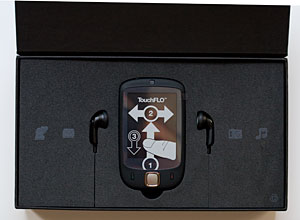
Design and Ergonomics
This is a beautiful and small phone. It looks elegant, extremely modern and sexy. Did we mention it's small and light? Check out the comparison photos of the Touch and the original Motorola RAZR V3. The Touch has the same rubbery soft-touch finish as the T-Mobile Dash (aka HTC S620) and Wing: it feels great and helps keep the device securely in hand. The matte black finish does show fingerprints, but not as much as glossy phones. A chrome strip wraps around the edges of the phone, again making for a great look. The device is made of plastic, including the chrome trim. The curved corners and bottom taper make it feel natural in the hand and there are no edges to catch on pants pockets nooks and crannies. At 3.95 ounces (112 grams) and 0.55" (13.9mm) this is the smallest Windows Mobile Professional phone on the market.

Motorola RAZR V3 and the HTC Touch. | 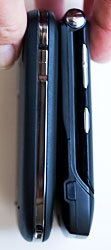
The HTC Touch and the RAZR V3. |
There are relatively few controls (despite the touch screen, we'd like more). There's a 5-way directional pad below the display which works well and easily, the power button up top (takes some effort to press, and that's a good thing), the camera button and a volume slider with a center ridge for better grip. Two Windows Mobile softkey buttons the d-pad, and that's it. No OK or Windows Start Menu buttons, no voice command button-- nothing. This adds to the Touch's minimalist design but it means you'll be missing a few keys that speed up interaction with the device.
 | |
The battery lives under the back cover, and the entire cover slides off, rather than just a section. You slide upward in the direction of the camera lens, and we found it very hard to get off with the exception of one staff member who made it look easy. Alas, the rest of us couldn't master the trick. Though the SIM card and Micro SD card slots are under a pop-out section of that chrome trim rather than under the battery, unfortunately you'll still need to remove the battery cover to open that long chromed-plastic door. The door fights with you a bit as you try to access the slots, but we hope its rubbery-plastic mounts will withstand a few years of fighting.
The screen is bright and sharp, though it has more glare than other Windows Mobile Professional and Standard phones. The rear-firing loudspeaker is decently loud and sound through the included headphones is excellent for music playback.
Phone Features, Reception and Data
The HTC Touch is a triband 900/1800/1900MHz GSM phone that's unlocked for use with any GSM carrier. The phone lacks the 850MHz band used heavily by AT&T in the US and by T-Mobile for roaming service, but HTC tells us a triband 850/1800/1900MHz version will be out by the end of 2007. We have to wonder why it isn't quad band, though; global travelers will be at a disadvantage with a triband phone. As with most recent HTC-manufactured phones like the Wing and the Cingular 8525, call quality is excellent and the volume is average by GSM standards. Though not deafeningly loud, the speakerphone's quality is good through the small rear-facing speaker.
The Touch has Cyberon's Voice Speed Dial, but there's no hardware key assigned to this function, and the only user-assignable button is the camera button (which has only a press but not a secondary press-and-hold assignable application). Voice Speed Dial uses voice tags rather than true voice recognition, but it's very accurate and works with Bluetooth headsets and car kits. Like all Windows Mobile 5 and 6 phones, the Touch has call history, photo caller ID, and supports call waiting, conference calling and flight mode. For data speeds, the Touch got an average of 85k on T-Mobile US. You can also use the phone as a wireless modem for a notebook over Bluetooth, though EDGE speeds aren't as compelling as 3G.
Horsepower and Performance
This isn't the Touch's strong point: the 201MHz Texas Instruments OMAP 850 feels underpowered. This CPU has been used widely on MS Smartphone/Windows Mobile Standard devices, and overall it's a good fit for that platform. It's also been used in older Pocket PC Phone Edition PDA phones such as the T-Mobile MDA and Cingular 8125 as well as the new T-Mobile Wing, and it felt a bit slow but usable. It's even slower on the Touch, perhaps due to the demands of the touch interface. Quite often we though we hadn't had success touching an icon when the problem was really a long delay before the device responded by opening a window or launching an application. We found ourselves tapping and waiting quite a bit. Video playback of very low bitrate WMVs that even an 201MHz MS Smartphone / Windows Mobile Standard Edition could handle floundered on the Touch. For example, we tested two WMV files, one a short 420kbps flick and the other a 301 kbps movie and both dropped enough frames that playback was about 10 fps. Rebooting the phone and running no other applications other than Media Player Mobile improved things, but realistically it's not practical to reboot the phone every time you want to watch a video.

Top view. | Bottom view. |
The Touch has the standard 64 megs of RAM (used like RAM in your PC) and 128 megs of flash ROM (for storage). Of those, 20.8 megs of RAM are free at boot and ~ 32.4 megs of flash memory are available for storage. You can further extend storage using the included 1 gig Micro SD card. Like the Wing, the Touch is SD 2.0 compatible which means it should support SDHC cards greater than 2 gigs in capacity though we don't have one of those to test yet.
Camera
The 2 megapixel CMOS camera with fixed focus lens takes acceptable photos, though not as good as the HTC TyTN (Cingular 8525) 2 MP camera. Given how little room there is inside the phone for camera hardware, we're not surprised that image quality took a hit compared to its much bigger brother. Images suffer from excessive foreground sharpening (so much so that detail is actually obliterated) that jars with un-sharpened background areas and creates a sense of limited focus. When resized down to VGA or 800 x 600, photos look decent but they still lack natural detail and contrast and white out add harshness to the images. Images sometimes have a purple color cast, as you can see in the photo of the dark gray buddha to the right.
 |  |
The camera can take photos at a maximum of 1200 x 1600 pixels, with lower resolutions available that are suitable for Today Screen backgrounds, MMS and caller ID. There are 4 quality settings, center and average metering options, a shutter sound that can be turned off, a self-timer and more. There are two video modes: standard and MMS. Standard video resolutions are unambitious: 128 x 96 and 176 x 144, but they do look decent, albeit small. Standard video mode supports H.263, MPEG4 and Motion JPEG file formats. MMS video supports H.263 and MPEG4 and offers the same resolutions as standard video. The camera has a self-portrait mirror but no flash.
WiFi and Bluetooth
The HTC Touch has 802.11b/g WiFi. WiFi worked reliably for us on our encrypted 802.11g network and range was good for a Pocket PC phone (despite the phone's small size). Data speeds averaged 1097 kbit/s, which is middle of the pack for Windows Mobile devices. The WiFi status control panel applet shows current SSID, mode (Infrastructure or ad hoc), Tx and Rx rates, BSSID, channel and signal strength. You can set the amount of power the WiFi radio consumes using a 3 position slider, set up LEAP and secure certificates.

Left side. | Right side. The SIM and MicroSD card slots are under the middle section of the chrome trim on this side. |
Microsoft's Bluetooth stack and fairly plain user interface handle Bluetooth connections for the Touch, like all recent HTC phones. It has Bluetooth 2.0 and supports most common profiles including serial port, FTP, HID (keyboard and mice), headset, hands free, DUN (dial up networking for using the phone as a wireless modem for a notebook or desktop), and A2DP Bluetooth stereo. We tested the Touch with the Plantronics Discovery 655 and the Samsung WEP-200, and both worked well with good voice quality and and volume. We tested A2DP using the Plantronics 590a Bluetooth stereo headset and when we paired it, the Touch asked if we wanted to use it for stereo, handsfree or both. We selected "both" and all controls worked properly. Audio quality was very good, with clear stereo separation, strong bass and non-harsh trebles with plenty of volume. Very nice.
Battery Life
Here's where the Touch makes up for its weak CPU performance: battery life is superb by Windows Mobile Professional standards. The phone lasted 3 days on a charge with moderate use (about twice as long as the HTC TyTN/Cingular 8525) and longer with very light use. HTC claims 5 hours of talk time and 200 hours of standby and that's reasonably accurate according to our tests (we got 4.6 hours talk time). Standby was right on target. Given the wide range of things you can do with Windows Mobile phones, it's hard to describe an average usage scenario, but we tested the phone by making calls, listening to MP3s for an hour each day, watching a 2 minute video each day, looking up calendar and contacts information, checking email manually 8x/day and surfing the web over EDGE with Bluetooth left on at all times. WiFi will consume battery life faster, as will streaming media, though given the Touch's weak video playback performance we don't foresee many folks watching hours of video on the device.
Conclusion
The HTC Touch is a beautiful, very small PDA phone, something we just about never get to say. It's the perfect phone for style conscious buyers who need a PDA's features and advanced functions, but don't want to carry an ugly brick. However, those who text or email frequently won't be happy with the tiny on-screen keyboard and (very functional) handwriting recognition. The Touch isn't meant to compete with hardware-keyboarded PDA and smartphones like the Treo 750, Cingular 8525, T-Mobile Dash or BlackBerry 8800. And while the touch user interface is a step in the right direction, it's really just one application launcher rather than a pervasive change to the phone's interaction on the whole.
Pro: Beautiful, very light and very small. Touch screen is a step in the right direction. Excellent music playback quality through the included wired stereo headset and through stereo Bluetooth headphones. Very good battery life by Windows Mobile Professional standards. Bluetooth 2.0 and WiFi 802.11b/g keep you connected and WiFi helps with the lack of 3G.


 05:17
05:17
 Information technologies
Information technologies





